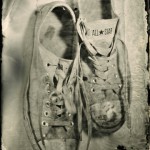Many photographers today are reviving the photographic processes of the Civil War era. A California news article reports on several photographers in San Francisco who are producing photographs with the wet-plate process. Even Louis Vuitton highlights wet-plate photography in his digital project Double Exposure for the Fall/Winter 2011/2012 ad campaign. Notice how both the news article and film clips emphasize the portrayal of character in wet-plate photography. What do you think are some reasons for the nostalgic return to nineteenth-century processes?
Read the article on San Francisco-area photographers here:
Watch a video on Sam Taylor-Woods, one of the photographers on the Vuitton campaign:
Explore the official site of Louis Vuitton’s Double Exposure campaign on Facebook:





I feel the nostalgic comes from all the work that must be done to get one photo. see photographers when taking regular photos with regular cameras take a picture and if it didnt come out perfect they can either take it again or fix it later. but with this processes you have to get everything right from the camera postion to the models stance the lighting etc and theirs a art in all that, that you dont see anymore.In this fast pace life that we live sometimes it nice to do it the old fashion way and feel that since of history or get that quality that all to often we forget or dont have.
Old ways of creating photography is something unusual nowadays. There are hundred thousands of professional photographers and many more amateur and all of them, with a few exceptions, use modern technology cameras. These cameras are fast and advanced, but produce more or less the same image, unlike the old process, which takes a lot more time. However pictures produced using wet-plate technique are in some sort unique. These pictures are unusual, which makes them more appealing to the public. Photography as any other businesses are looking for a new ways to excite consumers so they can promote and sell bigger quantity of their products. Thus producing something that all other lack gives you a better chance of success. After all all that is old becomes new again.
Some reasons for the nostalgic return to nineteenth century processes because of interest, uniqueness and the ability to know the difference between the cameras in the 21st century and the wet plate process decades ago. Also, not many know what the wet plate process is so Louis Vuitton’s campaign introduces the wet plate process and made it popular as well as the company name. The double exposure Facebook site initiates a more modern look and Louis Vuitton is broadcasting a process that take more time then the cameras now.
The wet plate collodion process truly is one of a kind because of the ghostly unfinished look which is only obtain through the wet plate process. I think its amazing how we still haven’t been able to figure out another way of creating this unique look with out having to go through a time consuming process. The reason why some photographers are seeking this old method is to set themselves apart from their competition. Another reason might be to further convey their story or message with its authentic style. I can also agree with Denis when he says “all that is old becomes new again” because when we run out of ideas we tend to reference the past.
I think reason for photographers to return to nineteenth-century process of the wet-plate is because of the look of the photos. When you take a wet-plate photo it has this vintage, old look to it. It’s a straight on photo of the subject or object and sometimes can give a different look to them. Another reason could be that it’s the photographers style, they can like they old look. Or they want to do something different from others. Instead of taking a digital photo that you can change or fix and just point and shoot, they might want to get the experience of a different style, make themselves a better photographer by putting more time and attention to their photos. It’s not a bad thing to go back to what started photography, to use the old methods and be different. That’s what makes photography exciting.